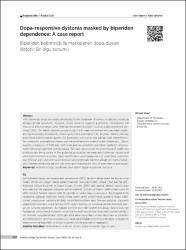Dopa-responsive dystonia masked by biperiden dependence: A case report
Citation
Ahmet, Ü. Z. E. R. (2023). Dopa-responsive dystonia masked by biperiden dependence; a case report. Anatolian Clinic the Journal of Medical Sciences, 28(3), 420-424.Abstract
Anticholinergic drugs are widely employed for the treatment of various conditions, including extrapyramidal symptoms. However, recent research suggests a potential link between the misuse of anticholinergics and inherited movement disorders, such as dopa-responsive dystonia (DRD). This report presents a case study of a 61-year-old woman who had been experiencing involuntary movements, including dystonia and tremors, for 30 years. Initially, she was prescribed anticholinergic agents like biperiden, which provided partial relief. Nevertheless, her symptoms gradually worsened, and she developed a tolerance to anticholinergics. Subsequently, a diagnosis of DRD was confirmed, and her symptoms exhibited significant improvement following treatment with levodopa. This case underscores the importance of healthcare professionals being aware of the potential association between anticholinergic misuse and inherited movement disorders. Early identification and management of underlying conditions like DRD can aid in preventing unnecessary and potentially harmful utilization of anticholinergics, thereby enhancing patient outcomes and reducing the risks of dependence and abuse.Anticholinergic drugs are widely employed for the treatment of various conditions, including extrapyramidal symptoms. However, recent research suggests a potential link between the misuse of anticholinergics and inherited movement disorders, such as dopa-responsive dystonia (DRD). This report presents a case study of a 61-year-old woman who had been experiencing involuntary movements, including dystonia and tremors, for 30 years. Initially, she was prescribed anticholinergic agents like biperiden, which provided partial relief. Nevertheless, her symptoms gradually worsened, and she developed a tolerance to anticholinergics. Subsequently, a diagnosis of DRD was confirmed, and her symptoms exhibited significant improvement following treatment with levodopa. This case underscores the importance of healthcare professionals being aware of the potential association between anticholinergic misuse and inherited movement disorders. Early identification and management of underlying conditions like DRD can aid in preventing unnecessary and potentially harmful utilization of anticholinergics, thereby enhancing patient outcomes and reducing the risks of dependence and abuse.
















